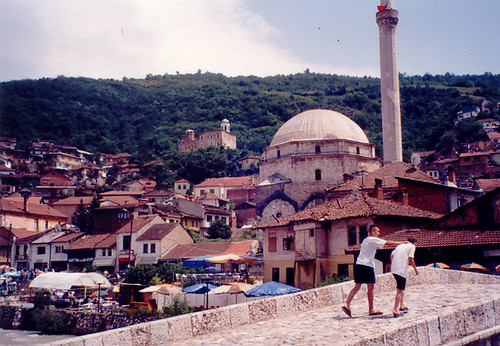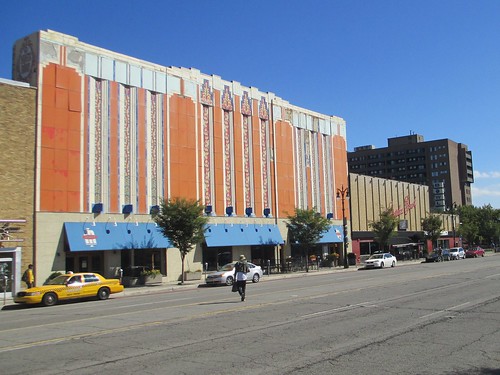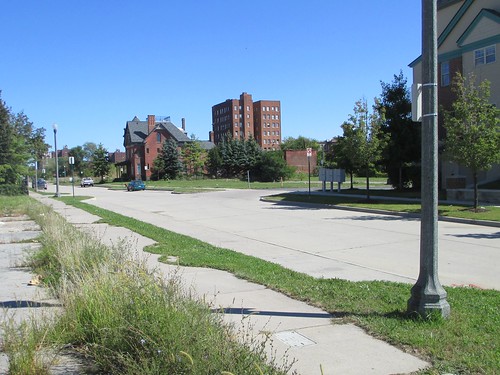It wasn’t a great start to my first driving lesson. Aged 17, a minute
into my introductory driving session with my dad on a local
industrial estate, we came to a T-Junction, where he told me to turn left.
Still unfamiliar with the accelerator pedal’s sensitivity and the steering
required to turn a corner, I turned the wheels through 45 degrees and stepped –
rather hard, it turned out – on the gas. Seconds later, having demolished a
small tree on the way, I had wedged the car firmly onto a low wall round a nearby
building.
 |
| Prizren, Kosovo, just after the war: against the odds, the Invisible Visible Man drove competently down a recently-bombed road near here. |
That still marks the only time in the many years since that
I’ve caused direct (as opposed to environmental) damage or injury with a car. I’ve driven many thousands of miles,
navigated cars down recently-bombed roads in Kosovo and survived an attempt by
rioting youths in Belfast
to hijack a car I was driving. Yet I can’t pretend I get on with cars the way I
do with bikes. There are few feelings of relief greater for me than the moment
I finally drop off a hire car, having damaged neither it nor anyone else during
my time in charge.
It was consequently with a sinking heart that I recognised
last week that, no, I was going to need a car to get to my meetings in Detroit . I headed to a
downtown Enterprise
rent-a-car branch with a feeling of dread.
Yet, while I was mentally prepared for many of the
depressing aspects of driving a car, the overwhelming feeling I had while
driving my Nissan Versa was not the one I'd been expecting. I found myself more struck than ever before at the sensation of being trapped in a metal box.
That sensation took a while to come over me, however. My first feeling after I climbed in, adjusted the mirrors and pulled out onto the wide, bleak expanse of E Jefferson Avenue was simple boredom.
I ’m used to pedalling hard, looking over my shoulders, standing up at points and, on faster or windier bits of a ride, putting my hands down in the drop position on my handlebars. I shift gear regularly to match my pedalling to the bike’s speed. I push hard to restart from traffic lights.
In the car, I was reduced to turning my head a little
sometimes, glancing around in my mirrors, holding onto the steering wheel and
alternately pushing the accelerator or brake pedals. Given that the car had an
automatic transmission, there wasn’t even the modest physical activity of
engaging the clutch and moving the gear stick.
That mixture of passivity and onerous but dull responsibility puts me in touch with all the things I hate about having reached middle age. Have I checked my mirrors and blind spots before starting to signal for this manoeuvre? Have I got enough money in the right bank account for this month’s mortgage payment? It’s the diametric opposite of the youthful optimism that wells up inside me most mornings as I ride my bike.
That mixture of passivity and onerous but dull responsibility puts me in touch with all the things I hate about having reached middle age. Have I checked my mirrors and blind spots before starting to signal for this manoeuvre? Have I got enough money in the right bank account for this month’s mortgage payment? It’s the diametric opposite of the youthful optimism that wells up inside me most mornings as I ride my bike.
I’m almost overwhelmed when driving, meanwhile, by the
challenge of navigating the thing safely. The morning after I picked up the
hire car, I headed off for General Motors’ technical centre in Warren ,
outside Detroit .
The freeway on-ramp pitched me straight into the fast lane, which I couldn't escape. I was hemmed in on one side by other vehicles and by impatient other drivers
sitting right behind me. I pictured myself or one of the multiple vehicles
around me making a small mistake and our slamming into the concrete barriers
down the middle of the road. I had an almost tangible sense of how it would
feel – the jolting, the tearing of muscles, the fear, the noises.
 |
| Woodward Avenue in midtown Detroit: the kind of street that could have been designed - but probably wasn't - to intimidate occasional drivers like the Invisible Visible Man |
It was one of several incidents that brought home to me how
much bolder those around me are about speed, the time they need to switch lanes and so on. Although I think much of my caution is warranted, I feel within
like a small, weak, rather scared person. It doesn’t help that when I’m on work
trips I’m invariably tired, under pressure and running late. “Why did I sit up
late writing that story last night?” I find myself asking as I struggle to
shake off the cloudy fatigue in my brain. Then I notice that every time the
car’s speed drops below 60mph the satellite navigation system’s estimated time
of arrival at my destination slips a little further past the time I was meant
to be there. I push myself mentally to focus harder, press down a little on
the accelerator and carry on.
Yet the biggest shock to me on this trip was a result, I
think, of a recent change in the way I’ve been cycling. I’ve been trying more
and more to communicate with other road users, warning them of my presence,
thanking them when they’ve acted safely or pointing out when I have a traffic
light in my favour. It’s a habit I’ve developed partly in an effort to keep myself safe – but also because I want generally to communicate to others on the
road our shared humanity. Most people find it harder to behave callously
towards someone who’s made it obvious that he or she is as real and sensitive a
human being as themselves.
When I found myself pitched into that highway fast lane, by
contrast, I was struck dumb. The drivers around me could barely see me. They
were aware only of how my slow-moving, poorly-positioned car was holding them
up. My means of communicating were restricted to the use of two pathetic sets
of blinking lights saying only, “I would like to turn left” or “I would like to
turn right”. I could, I suppose, have honked the horn, as many New York City drivers do, but I never quite summoned up the aggression that seems to
require.
 |
| The Shinola bike works shop in Detroit. Can you guess where the Invisible Visible Man ends up when he feels homesick on a trip? |
I consequently wandered the freeways of south-east Michigan a little bit
lost, a little bit unsure of myself and a little bit anxious – but suffering a
kind of automotive locked-in syndrome. “I’m a Nissan Versa and I would like to
turn left” and “I’m a Nissan Versa and I would like to turn right” were the only two messages I could convey.
As a result, I had a particularly intense sense when I
returned the hire car of how the stress hormones were withdrawing from my
system. The attendant checked the car for new scratches, found none, and I
handed back the keys for the next lucky driver. I climbed instead into the
large and luxurious Jeep Grand Cherokee of the public relations executive with
whom I was to lunch.
 |
| The Brooklyn Bridge Bike Lane: I ride so fast here, it seems, I don't even recognise people I sweep past every morning. |
The relief was all the greater the next morning when, back
in New York , I returned to my normal routine,
riding across the Brooklyn Bridge into lower Manhattan . The pleasure even cancelled out my
irritation at finding building work was obstructing the “bike lane” – the space
dedicated to double-parking and deliveries – on Reade Street in TriBeCa. Conscious that other riders would probably feel less cautious than I about
squeezing through the remaining space, I nevertheless tried to wave the woman following me
through ahead of me.
Her response illustrated precisely what I’d been missing
locked up inside that car. She insisted I went ahead, saying, “You’re faster
than me.” I didn’t understand why. I looked quizzically at her
after we’d both reached the next set of traffic lights. “You’re faster than
me,” she said. “I see you ride past me every morning on the bridge.”

"That still marks the only time in the many years since that I’ve caused damage or injury with a car."
ReplyDeleteKevin's comment: I strongly doubt the truth of this statement. Car drivers, by way of their lethal poisons, kill and injure a large number of people.
For example, Toronto's Medical Officer of Health reports that in this city, every year:
Car drivers poison and kill 440 people every year.
Car drivers poison and injure 1,700 people so seriously they have to be hospitalised.
Children and the elderly are most vulnerable to being poisoned by car drivers, with children being the victims of 1,200 acute bronchitis attacks and 68,000 asthma symptom days every year due to being poisoned by car drivers.
The mortality costs alone are $2.2 billion due to people being poisoned by car drivers.
The horrific details may be seen on the City's official website at:
http://www.toronto.ca/health/hphe/pdf/air_pollution_burden_backgrounder.pdf
And that is in just one city!
Think of it this way: Each of the thousands of fine particles in the particulate poisons given off by car drivers is like a lottery ticket. Everyone who breathes in one of those particles is playing the lottery and the "winner" gets cancer.
So no, you don't get to say that you have only caused damage or injury once. You have poisoned many, many people and there is a disturbingly high probability that you have killed or seriously injured one or more of them. Quite possibly an innocent child.
Kevin,
DeleteThanks for your comment.
I drive pretty rarely. It was more than a year between this last time I drove and the time before. I drive pretty modest-sized cars on the rare occasions I drive and I drive them at modest speeds, conserving fuel. Clearly, I create emissions. But I'm in the rare position of cycling far more every year than I drive (around 4,500 miles by bike against maybe 200 or so by car). So I'm not the most likely candidate to have killed a child through my emissions.
You are, nevertheless, right that emissions from driving and flying are a serious matter. I should probably have said "the only time in the many years since that my negligence with a car has directly caused damage or injury".
Invisible.
If we are going to do creative accounting...
DeleteThere are probably of the order of 1 million drivers in Toronto. That would mean that each one is responsible for about 0.0005 poisoning deaths per year. And if we consider that the Invisible Visible Man drives about 50 times less than the average by his reckoning, he has poisoned to death about 0.00001 people per year. The chances he has "caused" the death of anyone by these means are slim; more than one, virtually impossible.
That's the problem with statistical deaths--you can't pin them on anyone. But what's striking to me of the numbers you quote is the monetary cost: even divided among 1 million drivers, the price is far from negligible: over $2000/year. There should be a tax of that magnitude to compensate, but of course there isn't.
Kevin likes to pick nits. However, there ARE lots of ways we each hose up the system even if we avoid carelessly motoring. Which reminds me to fix up my fixie...
ReplyDeleteWe like pick nits in our family too, SteveA, especially after the children's school has sent home one of those special letters.
DeleteI seek to avoid carbon emissions as far as I can. But I have to do a certain amount of travel to do my job. I'd like to do more of it by train but it's not always possible. I'm feeling the lack of train options for some trips particularly strongly at the moment because my next trip is probably going to be to Chattanooga, TN.
All the best,
Invisible.
If you consider a body count of 440 dead people in one city alone to be a "nit," I am mildly curious as to what body count you require to classify it as "horrific mass killing."
DeleteI don't think either Steve or I was attempting to suggest the deaths from car emissions were "nits", Kevin. I think the point was that someone who drives maybe 200 miles a year and cycles 4,500 is probably less complicit in the mass slaughter than, say, someone who drives an average amount. I've written before about the danger of car emissions and how people don't take them seriously enough (http://invisiblevisibleman.blogspot.com/2013/01/a-blown-nose-blown-world-environment.html). I've also changed the wording of the piece to reflect your comment. So I don't think I'm downplaying the issue, even if you think I am.
DeleteInvisible.
This comment has been removed by the author.
DeleteAh. Then I misunderstood Steve's comment.
DeletePerhaps what he meant to say was "Why are you criticizing Robert when there are other people who are 100 times worse?"
Which is a reasonable question. And it has three answers. The first reason is that people whom I admire and respect, such as Robert, I tend to hold to a higher standard.
The second reason is for the same reason that I criticize the NYPD when there are police forces who are much worse. Yes, Robert Mugabe's police force is a bunch of thugs who divide their time between beating up his political opponents and shaking down the people for bribes. But that doesn't excuse NYPD's "stop and frisk" or "no criminality suspected" policies.
Third, and perhaps most important, is that what Robert wrote is simply not true. And it is a particularly dangerous falsehood to say that a car driver has not harmed anyone if they avoided hitting and crushing them. Someone who was poisoned is just as dead as someone who was crushed to death.
Kevin,
DeleteAs I noted above, I've changed what I initially wrote to take into account your original point.
Secondly, I really do my best to minimise my emissions consistent with working as a reporter covering things throughout the United States and occasional visits back to the UK. The small amount of driving in did in south-east Michigan - maybe 150 miles or so - were the first time I'd driven in more than a year. In the intervening time, I've cycled around 5,000 miles. So my overall proportion of the US's traffic carbon emissions over that time has been sufficiently tiny that I think it unlikely - call me callous - that my emissions have been the ones that finally did for some child. Maybe I'm wrong, of course.
The other thing to bear in mind, of course, is that, on a poetry to textbook continuum of the purpose of a piece of writing, this blog is largely meant to be at the textbook-ish end of poetry. It was mainly meant to be telling you how miserable being in charge of a car makes me.
I swear that, yes, I do care about carbon emissions.
Being more textbook-ish for a moment, I also wish carbon emissions were better taxed, so that lower-carbon transport would become more attractive.
All the best,
Invisible.
This comment has been removed by the author.
DeleteNot sure why you're so traumatized by Detroit streets. Sure, you're zipping across 696, or up I-75 or so forth, while other cars zip by; but how is that different than taking 2nd Ave, or the LIE?
ReplyDeleteIn both cities, you still have to be on your guard at all times. In fact, I think it's more stressful driving in NYC. The drivers here are much worse at cutting you off or changing lanes without signaling.
Do you find driving in NYC more humanizing, b/c sometimes you can make eye contact and give way?
Nevertheless, I agree w/you re: the joy you feel when you're finally back on your bike. People don't know how wonderful it is to propel yourself on your own power. To be a part of the street scape, instead of just passing over it (or under it, if taking subway).
Did you try Slows BBQ or Buddy's Pizza?
JarekAF,
DeleteThank you for the comment. There's a simple reason why I find driving in Detroit more stressful than driving in New York City: I never drive in New York City. I can well imagine it would be worse. But, since I arrived full-time in the US, the only two times I've needed to drive have been in south-east Michigan.
As for the restaurants, no and no. But I'll be back for the auto show, so I'll try them then perhaps.
All the best,
Invisible.
This comment has been removed by the author.
Delete